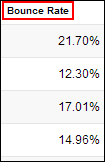Hard and Soft Bounce Rates in Natural Search
Greater detail and understanding of bounce rates
How Is 'Bounce Rate' Defined in Google Analytics?
According to the Google Analytics API documentation, the definition of 'bounce rate' is as follows:
ga:entranceBounceRate:
The percentage of single-page visits (i.e. visits in which the person left your site from the entrance page).
Calculation: (ga:bounces / ga:entrances) * 100
Essentially, if a particular page has a high bounce rate, a high number of people have landed on that page and not visited anywhere else on your site. On its own this may not be a bad thing: people may have landed on a blog post, taken a while to read, felt satisfied, and then scooted elsewhere. The context is all, which is why we like to drill a little deeper and identify hard bounce and soft bounce rates.
Bounce rates are pretty easy to spot in Google Analytics, you can see them on most standard reports:

There's also buckets of information relating to bounce rate out there, a couple of links we find useful:
And the following video is also pretty informative (contains the immortal line "I came, I puked, I left" - bit over-simplistic, but gives you the idea):
Hard Bounce
So we define a 'hard bounce' as:
- A natural search request.
- Bounce rate greater than 75% (which is high).
- An average time on site of less than or equal to 4 seconds.
In other words, someone has found that page via natural search, stayed for less than or equal to four seconds, then left the site. It's not a great sign. May well point to a mis-match between the search queries used to find the page and the content that they actually found on that page. Typically in such circumstances we examine the search queries (look at their key clusters if necessary) and compare them to prominent items of content on the page. Do these important items of content contain the necessary items of content?
Soft Bounce
A 'soft bounce' we define as:
- A natural search request.
- Bounce rate greater than 75% (a high bounce rate).
- An average time on site of greater than or equal to 30 seconds.
In this scenario a visitor has been on your page for quite a while, but after that time still decided that they'd like to go elsewhere, but not elsewhere on your site. It could mean that navigation on the page isn't providing clear messaging, it could mean that content is unrelated - it could equally mean that they've left happy and satisfied. It depends upon the nature of the site, the content, how frequently such rates occur (are there particular pages on which it occurs, etc), and other factors. With cases like these we may suggest using 'heatmap' technologies, such as Click Tale, or Crazy Egg to build up further insight as to what's going on.
Automating Hard and Soft Bounce Analysis
For a site with many thousands of pages of content (such as an ecommerce site), it's just not practical to manually dig out pages with hard and soft bounce rates. It's particularly not practical to then start examining referring search queries. Our tools do this and more. Do get in touch if you're interested to hear more.
